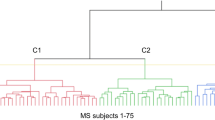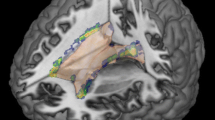Abstract
There is still a controversy regarding the best regional brain atrophy measurements in multiple sclerosis (MS) studies. The aim of this study was to establish whether, in a cross-sectional study, the normalized measurements of regional brain atrophy correlate better with the MRI-defined regional brain lesions than the absolute measurements of regional brain atrophy. We assessed 45 patients with clinically definite relapsing–remitting (RR) MS (median disease duration 12 years), and measured T1-lesion load (LL) and T2-LL of frontal lobes and pons, using a reproducible semi-automated technique. The regional brain parenchymal volume (RBPV) of frontal lobes and pons was obtained by use of a computerized interactive program, which incorporates semi-automated and automated segmentation processes. A normalized measurement, the regional brain parenchymal fraction (RBPF), was calculated as the ratio of RBPV to the total volume of the parenchyma and the cerebrospinal fluid (CSF) in the frontal lobes and in the region of the pons. The total regional brain volume fraction (TRBVF) was obtained after we had corrected for the total volume of the parenchyma and the CSF in the frontal lobes and in the region of the pons for the total intracranial volume. The mean coefficient of variation (CV) for RBPF of the pons was 1% for intra-observer reproducibility and 1.4% for inter-observer reproducibility. Generally, the normalized measurements of regional brain atrophy correlated with regional brain volumes and disability better than did the absolute measurements. RBPF and TRBVF correlated with T2-LL of the pons (r=−0.37, P=0.011, and r= −0.40, P=0.0005 respectively) and with T1-LL of the pons (r=−0.27, P=0.046, and r=−0.31, P=0.04, respectively), whereas RBPV did not (r=−0.18, P = NS). T1-LL of the frontal lobes was related to RBPF (r=−0.32, P=0.033) and TRBVF (r=−0.29, P=0.05), but not to RBPV (R=−0.27, P= NS). There was only a trend of correlation between T2-LL of the frontal lobes and RBPF (r=−0.27, P=0.06) and TRBVF (r=−0.28, P=0.057), and no correlation with RBPV (r=−0.23, P= NS). The magnitude of correlation between the expanded disability status scale (EDSS) and pontine and frontal lobe RBPF and TRBVF was more than twice as high as the correlation between EDSS and RBPV of the same regions. These data suggest that normalized regional brain atrophy measurements are preferable to absolute regional measurements in cross-sectional studies.


Similar content being viewed by others
References
Loseff NA, Wang L, Lai HM, et al. (1996) Progressive cerebral atrophy in multiple sclerosis. A serial MRI study. Brain 119:2009–2019
Inglese M, Rovaris M, Giacomotti L, et al. (1999) Quantitative brain volumetric analysis from patients with multiple sclerosis: a follow-up study. J Neurol Sci 171:8–10
Ge Y, Grossman RI, Udupa JK, et al. (2000) Brain atrophy in relapsing remitting multiple sclerosis and secondary progressive multiple sclerosis: longitudinal quantitative analysis. Radiology 214:665–670
Fox NC, Jenkins R, Leary SM, et al. (2000) Progressive cerebral atrophy in MS. A serial study using registered, volumetric MRI. Neurology 54:807–812
Saindane AM, Ge Y, Udupa JK, et al. (2000) The effect of gadolinium-enhancing lesions on whole brain atrophy in relapsing–remitting MS. Neurology 55:61–65
Simon JH, Jacobs LD, Campion A, et al. (1999) A longitudinal study of brain atrophy in relapsing multiple sclerosis. Neurology 53:139–48
Edwards SGM, Gong QY, Liu C, et al. (1999) Infratentorial atrophy on magnetic resonance imaging and disability in multiple sclerosis. Brain 122:291–301
Liu C, Edwards S, Gong Q, et al. (1999) Three dimensional MRI estimates of brain and spinal cord atrophy in multiple sclerosis. J Neurol Neurosurg Psychiatry 66:323–330
Bakshi R, Czarnecki D, Shaikh A, et al. (2000) Brain MRI lesions and atrophy are related to depression in multiple sclerosis. Neuroreport 11:1153–1158
Kappos L, Kesserling J, Radu EW, et al. (2001) Multiple sclerosis. Tissue destruction and repair. Measurement of atrophy. Martin Dunitz, London pp 91–98
Simon JH. (2000) Brain and spinal cord atrophy in multiple sclerosis. Adv Mult Scler 10:753–769
Schwartz M, Creasey H, Grady CL, et al. (1985) Computed tomographic analysis of brain morphometrics in 30 healthy men, aged 21 to 81 years. Ann Neurol 17:146–157
Hartmann P, Ramseier A, Gudat F, et al. (1994) Normal weight of the brain in adults in relation to age, sex, and weight. Pathologe 15:165–170
Phillips MD, Grossman RI, Miki Y, et al. (1998) Comparison of T2 lesion volume and magnetization transfer ratio histogram analysis and of atrophy and measures of lesion burden in patients with multiple sclerosis. AJNR 19:1055–1060
Rudick RA, Fisher E, Lee JC, et al. and the Multiple Sclerosis Collaborative Research Group (1999) Use of the brain parenchymal fraction to measure whole brain atrophy in relapsing–remitting MS. Neurology 53:1698–1704
Zivadinov R, De Masi R, Nasuelli D, et al. (2001) Magnetic resonance imaging techniques and cognitive impairment in early phase of relapsing–remitting multiple sclerosis. Neuroradiology 43:272–278
Whitwell JL, Crum WR, et al. (2001) Normalization of cerebral volumes by use of intracranial volume: implications for longitudinal quantitative MR imaging. AJNR 22:1483–1489
Turner B, Ramli N, Blumhardt LD, et al. (2001) Ventricular enlargement in multiple sclerosis: a comparison of three-dimensional and linear MRI estimates. Neuroradiology 43:608–614
Berg D, Maurer M, Warmuth-Metz M, et al. (2000) The correlation between ventricular diameter measured by transcranial sonography and clinical disability and cognitive dysfunction in patients with multiple sclerosis 57:1289–1292
Luks TL, Goodkin DE, Nelson SJ, et al. (2000) A longitudinal study of ventricular volume in early relapsing-remitting multiple sclerosis. Mult Scler 6:322–327
Brex PA, Jenkins R, Fox NC, et al. (2000) Detection of ventricular enlargement in patients at the earliest clinical stage of MS. Neurology 54:1689–1691
Redmond IT, Barbosa S, Blumhardt LD, et al. (2000) Short-term ventricular volume changes on serial MRI in multiple sclerosis. Acta Neurol Scand 102:99–105
Bermel RA, Bakshi R, Tjoa C, et al. (2002) Bicaudate ratio as a magnetic resonance imaging marker of brain atrophy in multiple sclerosis. Arch Neurol 59:275–280
Rovaris M, Comi G, Rocca MA, et al. and the European/Canadian Glatiramer Acetate Study Group (2001) Short-term volume change in relapsing-remitting multiple sclerosis. Effect of glatiramer acetate and implications. Brain 124:1803–1812
Poser CM, Paty DW, Scheinberg L, et al. (1983) New diagnostic criteria for multiple sclerosis: guidelines for research protocols. Ann Neurol 12:227–231
Lublin FD, Reingold SC (1996) Defining the clinical course of multiple sclerosis: results of an international survey. Neurology 46:907–911
Kurtzke JF (1983) Rating neurologic impairment in multiple sclerosis: an expanded disability status scale (EDSS). Neurology 33:1444–1452
Miller DH, Barkhof F, Berry I, et al. (1991) Magnetic resonance imaging in monitoring the treatment of multiple sclerosis: concerted action guidelines. J Neurol Neurosurg Psychiatry 54:683–688
Grimaud J, Lai M, Thorpe JW, et al. (1996) Quantification of MRI lesion load in multiple sclerosis: a comparison of three computer-assisted techniques. Magn Reson Imaging 14:495–505
Zivadinov R, Rudick RA, De Masi R, et al. (2001) Effects of intravenous methylprednisolone on brain atrophy in relapsing–remitting multiple sclerosis. Neurology 57:1239–1247
Zivadinov R, Sepcic J, Nasuelli D, et al. (2001) A longitudinal study of brain atrophy and cognitive disturbances in the early phase of relapsing–remitting multiple sclerosis. J Neurol Neurosurg Psychiatry 70:773–780
Kikins R., Shenton ME, Iosifescu DV, et al. (1996) Digital brain atlas for surgical planning, model-driven segmentation, and teaching. IEEE Trans Visual Comput Graph 2:232–241
Fukui T, Kertesz A (2000) Volumetric study of lobar atrophy in Pick complex and Alzheimer’s disease. J Neurol Sci 174:111–121
Miller DH, Barkhof F, Frank JA, et al. (2002) Measurement of atrophy in multiple sclerosis: pathological basis, methodological aspects and clinical relevance. Brain 125:1676–1695
Chard DT, Griffin CM, Parker GJM, et al. (2002) Brain atrophy in clinically early relapsing–remitting multiple sclerosis. Brain 125:327–337
Xu Y, Crampus J, O’Brien PC, et al. (2000) Usefulness of MRI measures of entorhinal cortex versus hippocampus in AD. Neurology 54:1760–1767
Pfefferbaum A, Mathalon DH, Sullivan EV, et al. (1994) A quantitative magnetic resonance imaging study of changes in brain morphology from infancy to late adulthood. Arch Neurol 51:874–887
Blatter DD, Bigler ED, Gale SD, et al. (1995) Quantitative volumetric analysis of brain MR: normative database spanning 5 decades of life. AJNR 16:241–251
Coffey CE, Lucke JF, Saxton JA, et al. (1998) Sex differences in brain aging. A quantitative magnetic resonance imaging study. Arch Neurol 55:169–179
Author information
Authors and Affiliations
Corresponding author
Rights and permissions
About this article
Cite this article
Zivadinov, R., Locatelli, L., Stival, B. et al. Normalized regional brain atrophy measurements in multiple sclerosis. Neuroradiology 45, 793–798 (2003). https://doi.org/10.1007/s00234-003-1101-2
Received:
Accepted:
Published:
Issue Date:
DOI: https://doi.org/10.1007/s00234-003-1101-2




